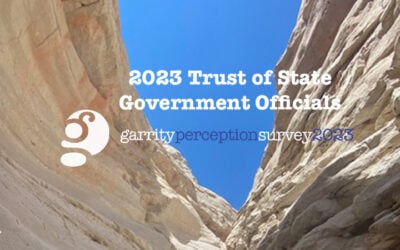GPS Analysis: Healthcare Industry
By Tom Garrity

The healthcare profession has some unique challenges when compared to other professions and industries. Timely access to medical providers, confusing and opportunistic insurance carriers as well as the lingering pandemic all impact perceptions of the medical industry. This overview of the 2023 Garrity Perception Survey highlights the favorability of the Medical System and trust of Doctors.
The Garrity Group Public Relations commissioned Albuquerque’s Research & Polling Inc. to measure New Mexico adult residents’ perceptions of various types of industries, institutions, people and professions in the state, as well as to determine which sources residents reference for news and information. Research and Polling conducted all the previous surveys since 2011.
A random sample of New Mexico adult residents was interviewed by telephone. All interviews were conducted between March 15 and April 2, 2023.
A sample size of 400 at a 95 percent confidence level provides a maximum margin of error of approximately 4.9 percent. In theory, in 95 out of 100 cases, the results based on a sample of 408 will differ by no more than 4.9 percentage points in either direction from what would have been obtained by interviewing all adult residents in New Mexico.

Favorability of the Medical System
According to the 2023 Garrity Perception Survey, a scientific survey of New Mexico residents conducted by Research and Polling, 43 percent of residents have a favorable impression of the medical system.
The industry, like seven others, are not viewed favorably. To increase trust, industries with favorability below 50% often need to share one or two points defending their field before proactively sharing something positive. Many medical systems are not aware of what points should be shares when defending the profession.
Getting into the cross-tab data of the 2023 GPS participants identifies these Medical System advocates: Seniors (55%), men (51%), Democrats (49%) and those with a high school education or less (48%).
Residents who are less likely to have a favorable impression of the medical system include Independent voters (34%), those with a graduate degree or higher (35%, those living in the Las Cruces/Southwestern (35) and Eastern (36%) regions, women (36%), and those under the age of 65 (39%).
Around New Mexico, the Medical System’s advocates can be found in Northwest New Mexico, where 54% of the residents have a favorable impression of the industry. That is followed by residents in North Central (46%), Albuquerque/Metro (45%), Eastern (36%) and Las Cruces/Southwest (35%).
Historically, the medical profession has never attained the coveted 50% level of favorability among New Mexico residents.

Since 2011, favorability has largely hovered between 49% and 47% statewide. However, since 2017 the favorable numbers have slipped in 2020 (44%) and 2023 (43%). The 2020 dip cannot be attributed to COVID-19 as the survey took place in January 2020, before the pandemic manifested itself in New Mexico.
Trust of the healthcare profession in New Mexico is influenced by a variety of factors. These can range from individual experiences to broader systemic and cultural issues. Key factors include:
- Quality of Care: The perceived and actual quality of medical care is a primary factor. This includes the effectiveness of treatments, the perceived competence of healthcare professionals, and the availability of resources and services.
- Access to Healthcare: Accessibility issues, such as long wait times for appointments, limited availability of specialists, and geographic barriers, particularly in rural areas, can erode favorability.
- Cultural Competency: New Mexico’s diverse population, including Native American, Hispanic, and other cultural groups, requires healthcare providers to be culturally competent. Respect for cultural differences and language barriers plays a crucial role in building trust and favorability.
- Government and Policy Influence: The role of state and federal policies, including healthcare funding, insurance regulations, and public health initiatives, can impact favorability.
- Media and Public Perception: The portrayal of the healthcare system and healthcare professionals in the media, including news and social media, can influence the public’s favorability, either positively or negatively.
Improving trust in the healthcare profession in New Mexico would likely involve addressing these various factors through policy changes, community engagement, improved communication and cultural competency, and efforts to reduce healthcare disparities.

Trust of Doctors
In comparison, 65 percent of New Mexico residents trust of doctors. Doctors and other front line medical professionals are the strongest assets of the medical profession. This high level of trust (over 50%) provides these professionals license to talk about the industries benefits, address what is working well and propose solutions to “fix” the medical system.
Residents who are more likely to trust doctors include residents with a graduate degree or higher (81%), Seniors (73%), and Democrats (73%).
New Mexico residents who are less likely to trust doctors include those under the age of 50 (58%), independent voters (56%) and voters who are registered as a Republican (59%).
Statewide, the trust of doctors is highest in the Northwest (74%), ABQ/Metro (65%), North Central (64%), Las Cruces/Southwest (61%) and Eastern (60%) New Mexico.
Historically, trust of doctors has fluctuated quite a bit since 2011 when 68% of residents say they trusted the professionals.

In 2014 trust dropped to 59% (lowest of the GPS survey period), increased to 67% in 2015 and then down to 60% in 2016. Since then, it has leveled out to an average of 65% level of trust, one of the most trusted professions in the state.
With high levels of trust, why are physicians akin to an endangered species?
Doctors leaving New Mexico, or facing challenges in retention and recruitment, can be attributed to several factors, many of which are common in other states but can be particularly pronounced in New Mexico due to its unique demographic, geographic, and economic characteristics. Key factors include:
- Rural Health Challenges: Much of New Mexico is rural, and rural areas often struggle to attract and retain healthcare professionals. Challenges include professional isolation, fewer resources, lower compensation compared to urban areas, and a higher workload due to a lack of specialists.
- Economic Factors: New Mexico, compared to some other states, has a lower average income and a higher poverty rate. This economic situation can affect the healthcare system’s funding and the compensation packages offered to doctors, making it less attractive compared to more affluent states.
- Limited Healthcare Infrastructure: There may be limited healthcare infrastructure, especially in rural and underserved areas. This can lead to challenging work conditions for healthcare professionals, who may face a lack of support and resources.
- Malpractice Insurance and Legal Environment: The legal environment in a state, including the cost of malpractice insurance and the frequency of malpractice lawsuits, can influence doctors’ decisions to practice in that state. States with high malpractice premiums or a reputation for litigious environments can be less attractive to physicians.
The Solution
Lack of understanding and connection with target audiences are two of many reasons why organizations and institutions struggle to be relevant, trusted and favored.
When The Garrity Group first commissioned the survey in 2011, we applied the valuable cross-tab information as a way to identify, understand and reach respective target audiences.
By identifying how our clients’ industries are Perceived by their Audiences, we Create a way for them to Engage relevant advocates (P A C E).
In short, the PACE solution leverages the demographic and geographic insights as a way for our clients to be relevant before their New Mexico audiences.
Our goal is not to change the perception of an industry or an institution, but rather to help an entity to become a trusted and favored source in spite of the industry or institution they are a part of. This has benefited organizations in the government, renewable, extractive, education, small business, corporate, accounting, commercial construction, mining and justice system.
All of these successes included:
- Identifying the target audience (whose opinion matters)
- Understanding/listening to their concerns and perceptions
- Measuring the input with organizational reality and goals
- Creating an approach to sharing the corporate values in a way that is relevant to the unique communities
This included the organization accepting the feedback, adapting their approach as appropriate and addressing the audiences with how their input created change. Think of it as a feedback loop that provides strategic guidance to build change.
For some organizations, this is like muscle memory. For others, the work is a bit more in-depth. In all instances, we have measurable results of how rebuilding trust and favorability improved engagement, connection and/or objectives.
Becoming trusted and favored using the PACE method, is complemented by focusing on research, planning, execution and evaluation, a process our team follows for all projects. This overview has provided only initial research and we look forward to continuing a more in-depth conversation to help your organizations be among the most trusted and favored.
To continue the conversation, make an appointment for a half hour consultation. Just visit GarrityPR.com and click on “Schedule a Consultation”.
featured articles
GPS ANALYSIS: Energy Industry
GPS Analysis: Energy Industry By Amanda MolinaEnergy is a defining issue in New Mexico. New Mexico’s oil and gas industry is fueling New Mexico's private and public sector. In 2022 the industry’s’ success generated recurring revenue for the state which surpassed $9.7...
2023 Trust of State Government Officials
The About Perception Podcast: 2023 Trust of State Government Officials By The Garrity GroupAdd a headline here if you want. Tom Garrity and Matt Grubbs talk about how state government officials are perceived in New Mexico.Full TranscriptTom Garrity [00:00:05] Welcome...
Los Alamos and Sandia Verses the New Mexico Film Industry
According to the 2023 Garrity Perception Survey (GPS) the National Laboratories (Los Alamos and Sandia) outpace
Schedule a Consultation
Request a time for your team to address a specific issue, learn more about the Garrity Perception Survey or lets discuss our work on your behalf.











